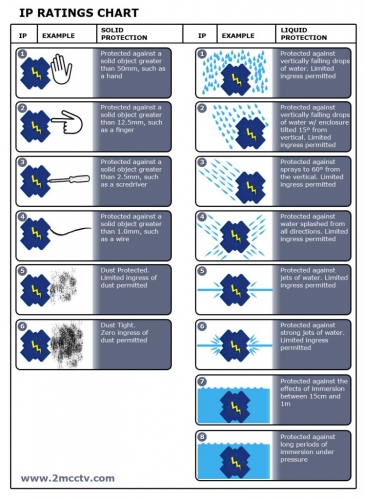The IP code is an internationally recognised classification system. It’s a standard way of describing.
Short for Ingress Protection Rating (or sometimes International Protection Rating), it classifies and rates the degree of protection provided against the intrusion of solid objects from hands to water droplets.
It’s particularly useful in engineering and manufacturing, because it gives us a clue as to the types of equipment we can use in difficult environments.
The IP code
The code itself comprises the letters ‘IP’ followed by two single digits. The first number indicates the level of protection the enclosure gives against solid particles. Liquid ingress protection is denoted by the second number.
Occasionally, you’ll see an IP code with an extra letter on the end: this is optional, and stands for ‘other protections’.
In the past, there was also a number to denote the mechanical impact resistance, but this is no longer used.

IP rating details
Solid particle protection
- 0 = no protection at all
- 1 = Protects agains objects larger than 50mm, like a fist – but if you put a little effort into touching the item in question, you won’t be protected
- 2 = Protection against objects larger than 12.5mm like fingers, or a Mars Bar
- 3 = Protection against objects larger than 2.5mm like tools, thick wires or your keys
- 4 = Protection against objects larger than 1mm, which includes most wires, screws, and anything else you may try to poke into the machine
- 5 = Dust protected: this provides complete protection against contact, and also prevents dust entering in quantities large enough to cause problems
- 6 = Dust tight: even the finest dust will give up in disgust.
Liquid ingress protection
- 0 = No protection
- 1 = Vertically falling water drips will not harm the equipment (equivalent to 1mm of rainfall per minute)
- 2 = Vertically falling water drips will not harm the equipment if it’s tilted at an angle up to 15° (equivalent to 3mm of rainfall per minute)
- 3 = Protection against spraying water at a pressure of 80-100kPa
- 4 = Protection against splashing water at the same pressure
- 5 = Protection against powerful jets of water
- 6 = Protection against water ingress when the object is immersed in up to one metre of water
- 7 = Protection against water ingress when the object is immersed in more than one metre of water
The ‘other protection’
Letters A-D detail specific items that cannot penetrate an item. The final four letters simply give a little more information about the test conditions that led to the IP rating assigned.
- A = Back of hand
- B = Finger
- C = Tool
- D = Wire
- H = High-voltage device
- M = Device moving during water test
- S = Device standing still during water test
- W = Weather conditions
IPX coding
The letter X is used to show that a manufacturer must avoid specifying a digit. There are a number of reasons for doing this, such as marketing considerations. IP2X is a commonly used rating on electrical items: for example, all plug sockets are IP2X, showing that they prevent people from sticking their fingers in the holes.
This is the really useful IP information…

All the above information is all very well, but here’s the really interesting part: people tend to assume that a nice big reassuring rating like IP67 will provide protection against everything. It won’t.
Immersion is different from spray jets: immersion won’t damage a piece of equipment rated IPX7. However, that same piece of equipment may be totally destroyed by exposure to jets of spraying liquid.
This can cause enormous problems when choosing equipment for challenging environments, and has taught us some hard but useful lessons recently. We took an IP67-rated piece of equipment to a factory which is sprayed with water regularly. Unfortunately, it wasn’t as waterproof as we were led to believe, so we’re having a rethink.
The moral of this blog? Choose your IP-rated equipment extremely carefully. If it’s spraying water you’ll be dealing with, choose IPX3. If you’ll be up against shallow immersion, choose IPX6. Don’t just go for IP67 and assume it will do the job.
